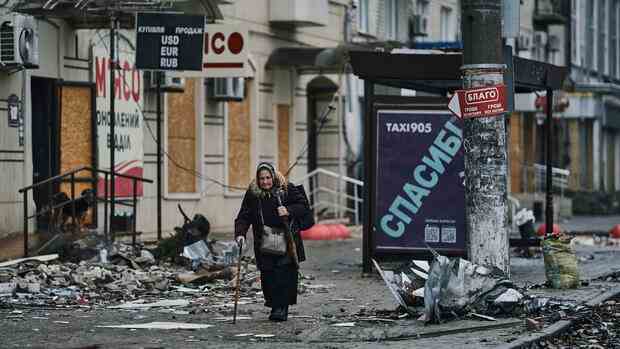Russia is increasingly attacking civilian infrastructure.
(Photo: dpa)
Vienna Last week, the Russian army launched another major attack on Ukrainian cities such as Kyiv, Kharkiv and Kryvyi Rih. The missiles specifically targeted the country’s energy infrastructure. The tactic is well known: since October 10, Russia has been targeting civilian infrastructure in waves. With this, Russia wants to demoralize the population and drive them to flee. But Ukraine is surprisingly quick to make repairs and get the electricity and water supply running again to some extent.
“Each new attack further weakens the Ukrainian power grid,” says infrastructure specialist Davor Bajs from the international organization Energy Community in Vienna. “The degree of destruction is constantly increasing, and the repair work will not change that.”
Bajs fears that one day repairs will no longer be possible and the high-voltage grid will collapse. “Small damage to him can be repaired, big ones can’t.”
The expert also believes that the damage inflicted by Russia will continue to weigh heavily on Ukraine. “Even if the war ended tomorrow, the country’s energy supply would still be affected for years to come.”
Top jobs of the day
Find the best jobs now and
be notified by email.
The Energy Community is an organization of the EU together with nine other Eastern European countries. Its purpose is to create and regulate a pan-European energy market. But with the escalation of the Ukraine war on February 24, 2022, the day-to-day business of the organization changed: now it is primarily about supporting Ukraine in supplying electricity.
Bottlenecks in substations
According to Bajs, Russia is targeting substations that play a key role in power supply. This assessment is consistent with statements made by representatives of the Ukrainian electricity industry.
>> Read also: “Every inch of Donbass is covered in blood, but Ukraine is resilient” – USA expect a long war
In substations, the voltage is reduced or increased. The electricity leaves a power station with a high voltage, but this must be gradually reduced using transformers to operate the coffee machine or computer.
The Ukraine is heading towards a dangerous bottleneck, especially when it comes to transformers. “The lead time for producing large devices is at least a year,” says Bajs. The major manufacturers do not stock transformers because the electricity suppliers usually know well in advance when they need a new machine.
That’s why the Ukrainian energy suppliers recently made do with used transformers. But here, too, the supply is scarce because the manufacturers manufacture the devices according to the needs of the customer. This limits the possibilities of handover from one electricity supplier to another.
Central Kyiv is without power after key civilian infrastructure was hit by Russian missile strikes in Ukraine.
(Photo: dpa)
In the next few days, one of the three Baltic states is supposed to deliver a suitable, used transformer to the Ukraine. However, the logistics are challenging, they say.
A nuclear accident would also threaten Western Europe
As an infrastructure specialist, Bajs is amazed at the resilience of Ukraine’s electricity supply. “How can a system that has suffered so much damage continue to function?” he asks rhetorically. He also sees this as a legacy of the Soviet Union. There and in general in the Eastern Bloc, great importance was attached to the redundancy of the power supply and a corresponding amount of money was invested in it.
>> Read also: Russian oil exports collapse – Kazakhstan wants to supply Germany
Nuclear power was also of great importance. However, Ukraine’s nuclear facilities remain a concern for energy specialists. Before February 24, 50 percent of Ukraine’s electricity came from nuclear power. The huge Zaporizhia plant with its six reactors is now off the grid; now three plants are still in operation.
Nuclear power plants need electricity to cool the fuel elements. If it fails, they threaten to overheat. For this emergency, nuclear power plants have diesel generators that provide bridging for up to ten days. After that, electricity has to provide cooling again.
This is one of the reasons why Ukraine’s power grid must not collapse under any circumstances – otherwise there is a risk of a nuclear accident, say experts. And Western Europe would also be affected.
More: EPP boss Weber calls Selenski’s visit to the USA a “wake-up call” – and calls for tanks for Ukraine.
